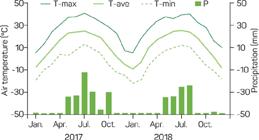Abstract
Background: Swallowwort (Cynanchum acutum subsp. sibiricum) poses significant challenges in cotton fields and orchards across northwest China.
Objective: Laboratory and greenhouse experiments were conducted to investigate the impact of various abiotic factors on seed germination of swallowwort.
Methods: Seed germination and seedling emergence of freshly harvested seed (FS) and seed stored for six months (SS) were investigated under different temperatures, osmotic potentials, saline stresses, and burial depths.
Results: The optimal germination temperature of FS was 30 to 35 °C, while that for SS was extended to 15 to 35 °C. Freshly harvested seeds germinated under alternating temperature regimes from 20/10 to 45/35 °C, but seed germination could reach to 60% at 15/5 °C after six months of storage. No germination of FS was observed at ≤ -1.0 MPa. However, seed germination remained at 44.6% at -1.0 MPa after storage. Saline stress reduced seed germination, with no germination observed at NaCl concentrations of ≥ 400 mM for the FS or ≥ 500 mM for the SS. However, pH values ranging from 5 to 10 had no significant impact on seed germination. The maximum seedling emergence (71%) was observed at the soil surface and no emergence at 10-cm burial depth.
Conclusions: Six months of storage enhanced seed tolerance to sub-optimal temperature, drought and salt stress conditions, comparing with FS. This made swallowwort more adaptable to harsh environments such as drought and salinity. Therefore, timely weed control is necessary to prevent seed production.
Keywords
Burial Depth; Cynanchum Acutum Subsp. Sibiricum; Osmotic Potential; pH; Salt; Storage; Temperature

 Seed and germination biology of swallowwort (Cynanchum acutum subsp. sibiricum)
Seed and germination biology of swallowwort (Cynanchum acutum subsp. sibiricum) Thumbnail
Thumbnail
 Thumbnail
Thumbnail
 Thumbnail
Thumbnail
 Thumbnail
Thumbnail
 Thumbnail
Thumbnail
 Thumbnail
Thumbnail
 Thumbnail
Thumbnail
 Thumbnail
Thumbnail
 Thumbnail
Thumbnail








